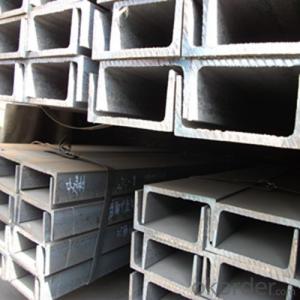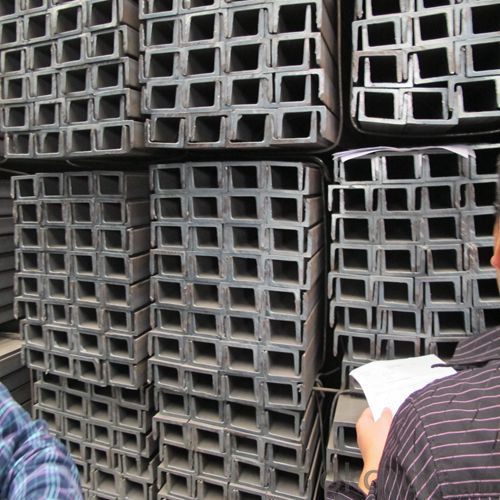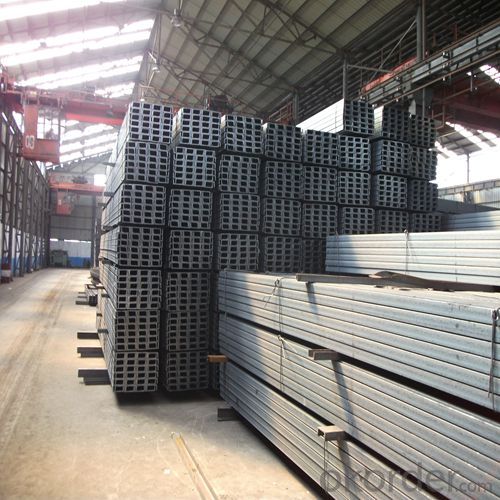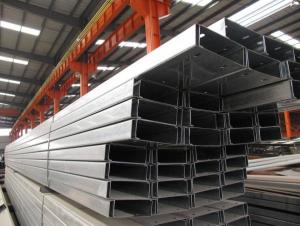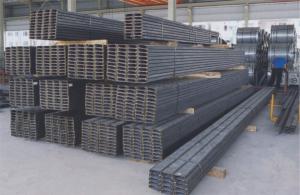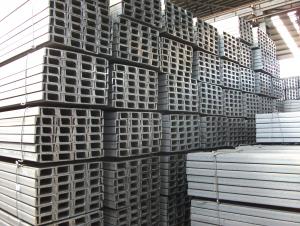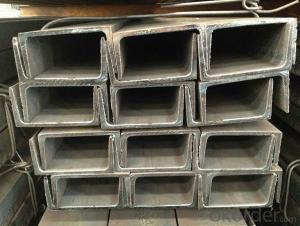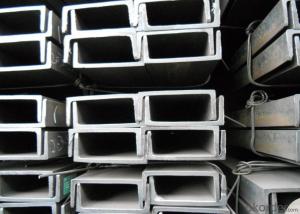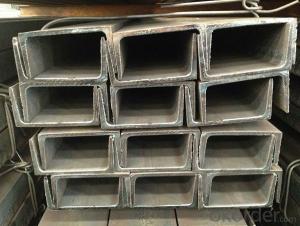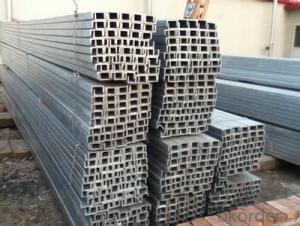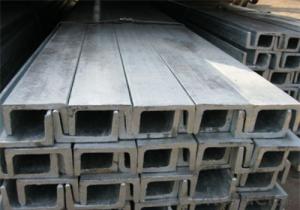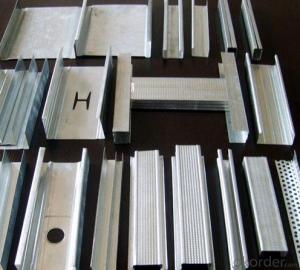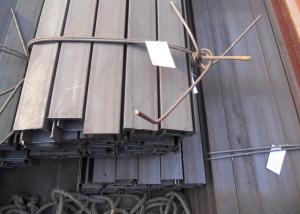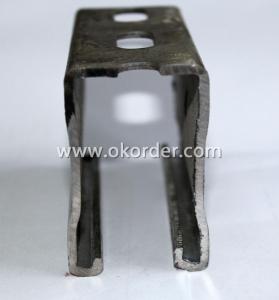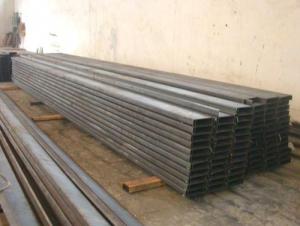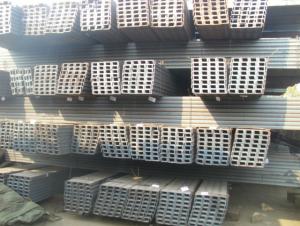U Channel Steel/Steel Channel /Galvanized Steel Channel Dimensions
- Loading Port:
- Tianjin
- Payment Terms:
- TT or LC
- Min Order Qty:
- 25 m.t.
- Supply Capability:
- 20000 m.t./month
OKorder Service Pledge
OKorder Financial Service
You Might Also Like
Product Description:
OKorder is offeringU Channel Steel/Steel Channel /Galvanized Steel Channel Dimensions at great prices with worldwide shipping. Our supplier is a world-class manufacturer of steel, with our products utilized the world over. OKorder annually supplies products to European, North American and Asian markets. We provide quotations within 24 hours of receiving an inquiry and guarantee competitive prices.
Product Applications:
U Channel Steel/Steel Channel /Galvanized Steel Channel Dimensions are ideal for structural applications and are widely used in the construction of buildings and bridges, and the manufacturing, petrochemical, and transportation industries.
Product Advantages:
OKorder's U Channel Steel/Steel Channel /Galvanized Steel Channel Dimensions are durable, strong, and resist corrosion.
Main Product Features:
· Premium quality
· Prompt delivery & seaworthy packing (30 days after receiving deposit)
· Corrosion resistance
· Can be recycled and reused
· Mill test certification
· Professional Service
· Competitive pricing
Product Specifications:
Specifications of MS Channel:
1.We supply high quality MS Channel at reasonable price, including Chinese standard, Japanese standard and so on.
Standard | GB/JIS |
Material Grade | Q235,SS400 |
Technique: | Hot Rolled |
Sizes as per chinese standard: | 50*37*4.5mm - 300*89*11.5mm |
Sizes as per japanese standard: | 50*25*3mm – 200*80*7.5mm |
Length: | 6meter, 9meter, 12meter |
Note: 1.we are also competent to provide our customers other MS Channel based on other sizes according to customer’s requirements.
2. The length of our ms channel could be cut into other meters as per customer’s requirements. For example, the channel in 6meters could be cut into 5.8meters in order to be fit in the 20ft container.
2. The detailed sections of MS Channel as per GB standard.are shown in the table-1:
GB U CHANNEL | Standard | Sectional | Dimension |
| Mass: |
| (mm) | (mm) | (mm) | (mm) |
|
50X37 | 50 | 37 | 4.50 | 7.0 | 5.438 |
63X40 | 63 | 40 | 4.80 | 7.5 | 6.634 |
80x43 | 80 | 43 | 5.00 | 8.0 | 8.045 |
|
|
|
|
|
|
100x48 | 100 | 48 | 5.30 | 8.5 | 10.007 |
120x53 | 120 | 53 | 5.50 | 9.0 | 12.059 |
140x58 | 140 | 58 | 6.00 | 9.5 | 14.535 |
140x60 | 140 | 60 | 8.00 | 9.5 | 16.733 |
|
|
|
|
|
|
160x63 | 160 | 63 | 6.50 | 10.0 | 17.240 |
160x65 | 160 | 65 | 8.50 | 10.0 | 19.752 |
|
|
|
|
|
|
180x68 | 180 | 68 | 7.00 | 10.5 | 20.174 |
180x70 | 180 | 70 | 9.00 | 10.5 | 23.000 |
|
|
|
|
|
|
200x73 | 200 | 73 | 7.00 | 11.0 | 22.637 |
200x75 | 200 | 75 | 9.00 | 11.0 | 25.777 |
|
|
|
|
|
|
220x77 | 220 | 77 | 7.00 | 11.5 | 24.999 |
220x79 | 220 | 79 | 9.00 | 11.5 | 28.453 |
|
|
|
|
|
|
250x78 | 250 | 78 | 7.00 | 12.0 | 27.410 |
250x80 | 250 | 80 | 9.00 | 12.0 | 31.335 |
250x82 | 250 | 82 | 11.00 | 12.0 | 35.260 |
|
|
|
|
| |
280x82 | 280 | 82 | 7.50 | 12.5 | 31.427 |
280x84 | 280 | 84 | 9.50 | 12.5 | 35.823 |
280x86 | 280 | 86 | 11.50 | 12.5 | 40.219 |
|
|
|
|
|
|
300x85 | 300 | 85 | 7.50 | 13.5 | 34.463 |
300x87 | 300 | 87 | 9.50 | 13.5 | 39.173 |
300x89 | 300 | 89 | 11.50 | 13.5 | 43.883 |
Table-1
3. The chemical composition of HR Channel Steel according to Q235B is shown in Table-2.
Alloy No | Grade | Element(%) | ||||
C | Mn | S | P | Si | ||
Q235 | B | 0.12-0.20 | 0.3-0.7 | ≦0.045 | ≦0.045 | ≦0.3 |
Table-2
Note: we are able to present our customers relevant SGS test report for chemical composition of HR Channel Steel.
4. The mechanical property of HR Channel Steel according to Q235B is shown in Table-3-1 and Table-3-2
Alloy No | Grade | Yielding Strength Point(Mpa) | |||
Thickness(mm) | |||||
≦16 | >16-40 | >40-60 | >60-100 | ||
≧ | |||||
Q235 | B | 235 | 225 | 215 | 205 |
Table-3-1
Alloy No | Grade | Tensile Strength(Mpa) | Elongation After Fracture(%) | |||
Thickness(mm) | ||||||
≦16 | >16-40 | >40-60 | >60-100 | |||
≧ | ||||||
G235 | B | 375-500 | 26 | 25 | 24 | 23 |
Table-3-2
Note: we are able to present our customers relevant SGS test report for mechanical property of MS Channel as customer’s request.
Applications of MS Channel:
The MS Channel can be applied to construction of warehouses, workshops, sport stadiums and car parks etc.The hot rolled channel steel belongs to carbon structural steel which is applied to in the field of construction and machinery.In details, the hot rolled channel steel is usually used for arch-itechtural structure, and they could be welded in order to support or hang a vari-ety of facilities. They are also usually used in combination with I beam. Generally,the hot rolled channel steel we supply must possess perfect welding property, riveting property and mechanical property and so on.
Package & Delivery of MS Channel:
1.The hot rolled channel steel will be packed in bundle with steel wire at each end of every bundle and color marking in order to help the customer to recognize his goods more easily at sight.
2. And the hot rolled channel steel could be loaded into 20ft or 40ft container, or by bulk cargo.If the weight of each bundle reaches more than 3.5 mt, the loading by break bulk cargo should be choosed.When the weight of each bundle reaches less than 3mt, the loading by container should be choosed.
3.As for the transportaion from mill to loading port, the truck will be usually used. And the maximum quantity for each truck is 40mt.
4.All in all, we could do in accordance with customer's request
FAQ:
Q1: How soon can we receive the product after purchase?
A1: Within three days of placing an order, we will begin production. The specific shipping date is dependent upon international and government factors, but is typically 7 to 10 workdays.
Q2: What makes stainless steel stainless?
A2: Stainless steel must contain at least 10.5 % chromium. It is this element that reacts with the oxygen in the air to form a complex chrome-oxide surface layer that is invisible but strong enough to prevent further oxygen from "staining" (rusting) the surface. Higher levels of chromium and the addition of other alloying elements such as nickel and molybdenum enhance this surface layer and improve the corrosion resistance of the stainless material.
Q2: Can stainless steel rust?
A2: Stainless does not "rust" as you think of regular steel rusting with a red oxide on the surface that flakes off. If you see red rust it is probably due to some iron particles that have contaminated the surface of the stainless steel and it is these iron particles that are rusting. Look at the source of the rusting and see if you can remove it from the surface.
Images:
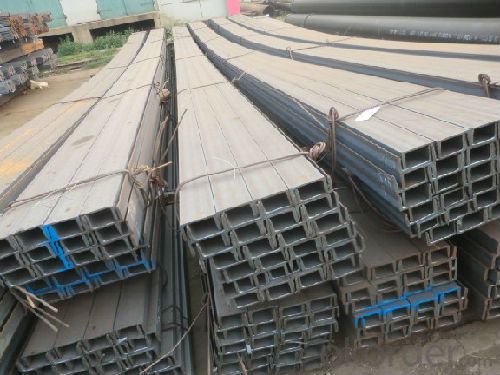
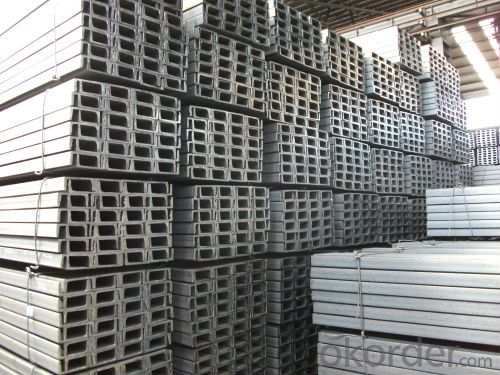
- Q:Can steel channels be used for curtain wall framing?
- Yes, steel channels can be used for curtain wall framing. Steel channels are often used in curtain wall systems for their strength and durability. They provide structural support and are able to withstand the load and pressure from the curtain wall system. Steel channels are versatile and can be designed to fit the specific requirements and dimensions of the curtain wall. Additionally, steel channels can be easily fabricated and installed, making them a popular choice for curtain wall framing.
- Q:14# dimension of channel steel and weight per metre?
- Dimensions and weight of light rolled channel steel14#a height (H) 140, leg width (b) 62, waist thickness (d) 4.9, theoretical weight 13.3 kg14# height (H) 140, leg width (b) 58, waist thickness (d) 4.9, theoretical weight 12.3 kg
- Q:How long do steel channels typically last?
- The longevity of steel channels can vary depending on several factors, including the quality of the steel, environmental conditions, and maintenance. Steel channels are renowned for their durability and resistance to corrosion, making them ideal for construction and industrial purposes. By installing them correctly and conducting regular inspections, steel channels can endure for 30 to 50 years or more. Nevertheless, it's worth noting that exposure to harsh chemicals, extreme temperatures, and heavy loads can impact their lifespan. To maximize their longevity, it's crucial to adhere to recommended maintenance practices and provide adequate protection.
- Q:What is the load-carrying capacity of steel channels?
- The load-carrying capacity of steel channels depends on various factors such as the dimensions and material properties of the channel, the type and distribution of the load, and the support conditions. Steel channels are typically designed to withstand both bending and axial loads. The load-carrying capacity of a steel channel can be determined using engineering calculations and standards such as the American Institute of Steel Construction (AISC) Manual. These calculations consider the section properties of the channel, including its moment of inertia and section modulus, which indicate its resistance to bending and deformation under load. The load-carrying capacity can also be influenced by the material strength of the steel channel. The yield strength and ultimate tensile strength of the steel determine its ability to resist deformation and failure under load. Higher strength steel channels can typically carry larger loads. Additionally, the support conditions of the steel channel play a crucial role in its load-carrying capacity. Channels with fixed or pinned supports will have different load-carrying capacities compared to those with simply supported or cantilevered ends. To determine the specific load-carrying capacity of a steel channel, it is recommended to consult engineering references, design codes, or consult with a structural engineer or steel manufacturer.
- Q:Are steel channels suitable for load-bearing walls?
- Typically, steel channels are not suitable for load-bearing walls. These walls are designed to bear the weight of a building or other structural elements, so they require materials that possess high compressive strength and stability. Steel channels, also referred to as C-channels or U-channels, are commonly utilized for non-structural purposes such as framing and supporting secondary components like cladding or drywall. They lack the necessary structural properties to withstand heavy loads and may not provide the required stability and rigidity. Load-bearing walls are typically constructed using materials like concrete, masonry, or steel beams that are specifically engineered to handle the forces involved in supporting a structure.
- Q:How do steel channels perform in coastal or saltwater environments?
- Coastal or saltwater environments are typically favorable for steel channels, although a few factors can influence their performance. To begin with, steel channels are generally resistant to corrosion, making them suitable for use in saltwater environments. However, it is worth noting that the degree of resistance may vary depending on the type of steel employed. Stainless steel channels, for instance, exhibit remarkable corrosion resistance due to the presence of chromium. Conversely, carbon steel channels may necessitate additional protective coatings to bolster their resistance to corrosion. Furthermore, the performance of steel channels in coastal regions can be impacted by airborne salt. Salt particles can settle on the surface of the channels, heightening the risk of corrosion. Regular cleaning and maintenance can help mitigate salt buildup and preempt potential damage. Additionally, when designing and installing steel channels in coastal or saltwater environments, one must take into account the possibility of exposure to high humidity, strong winds, and salt spray. Appropriate sealing, gasketing, and drainage systems must be implemented to prevent the accumulation of water or moisture, which can expedite the corrosion process. In conclusion, steel channels generally exhibit satisfactory performance in coastal or saltwater environments, owing to their inherent resistance to corrosion. Nonetheless, the specific type of steel employed, regular maintenance, and proper design and installation practices are crucial factors that can contribute to their long-term performance in such environments.
- Q:Can steel channels be used for window framing?
- Indeed, window framing can make use of steel channels. Steel channels possess strength and durability, rendering them suitable for bearing the weight of windows. Moreover, they can bestow additional stability and security to window installations. Furthermore, steel channels exhibit resistance against corrosion, a crucial quality for window frames that confront outdoor elements. On the whole, employing steel channels for window framing has the ability to augment the structural integrity and longevity of windows.
- Q:What are the cost considerations of using steel channels?
- Some cost considerations of using steel channels include the initial purchase cost of the steel channels themselves, the cost of transportation and delivery, as well as any additional costs associated with fabrication, installation, and maintenance. Additionally, factors such as the quantity and size of steel channels needed, market demand, and fluctuations in steel prices can also impact the overall cost.
- Q:Can steel channels be used for handrail supports?
- Yes, steel channels can be used for handrail supports. Steel channels are commonly used in construction for their strength and durability, making them an ideal choice for handrail supports. They provide stability and support to the handrail, ensuring its safety and longevity. Additionally, steel channels can be easily customized and fabricated to fit specific handrail designs and requirements.
- Q:Can steel channels be used in load-bearing walls?
- Yes, steel channels can be used in load-bearing walls. Steel channels are commonly used for structural support in construction projects due to their high strength-to-weight ratio. They are often employed in load-bearing walls to provide additional support and stability. Steel channels offer excellent load-bearing capabilities, as they can withstand heavy vertical and horizontal loads. Additionally, they can be easily integrated into the wall structure, making them a practical choice for load-bearing applications. However, it is important to consult with a structural engineer or a construction professional to ensure that the specific steel channels being used meet the required load-bearing capacities and comply with building codes and regulations.
1. Manufacturer Overview |
|
|---|---|
| Location | |
| Year Established | |
| Annual Output Value | |
| Main Markets | |
| Company Certifications | |
2. Manufacturer Certificates |
|
|---|---|
| a) Certification Name | |
| Range | |
| Reference | |
| Validity Period | |
3. Manufacturer Capability |
|
|---|---|
| a)Trade Capacity | |
| Nearest Port | |
| Export Percentage | |
| No.of Employees in Trade Department | |
| Language Spoken: | |
| b)Factory Information | |
| Factory Size: | |
| No. of Production Lines | |
| Contract Manufacturing | |
| Product Price Range | |
Send your message to us
U Channel Steel/Steel Channel /Galvanized Steel Channel Dimensions
- Loading Port:
- Tianjin
- Payment Terms:
- TT or LC
- Min Order Qty:
- 25 m.t.
- Supply Capability:
- 20000 m.t./month
OKorder Service Pledge
OKorder Financial Service
Similar products
Hot products
Hot Searches
Related keywords
